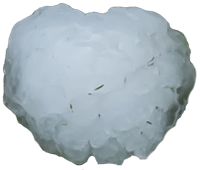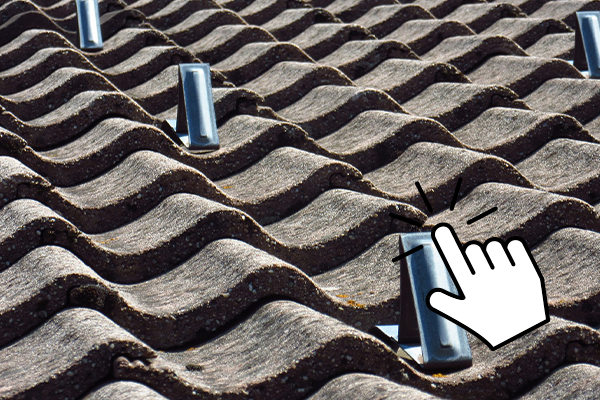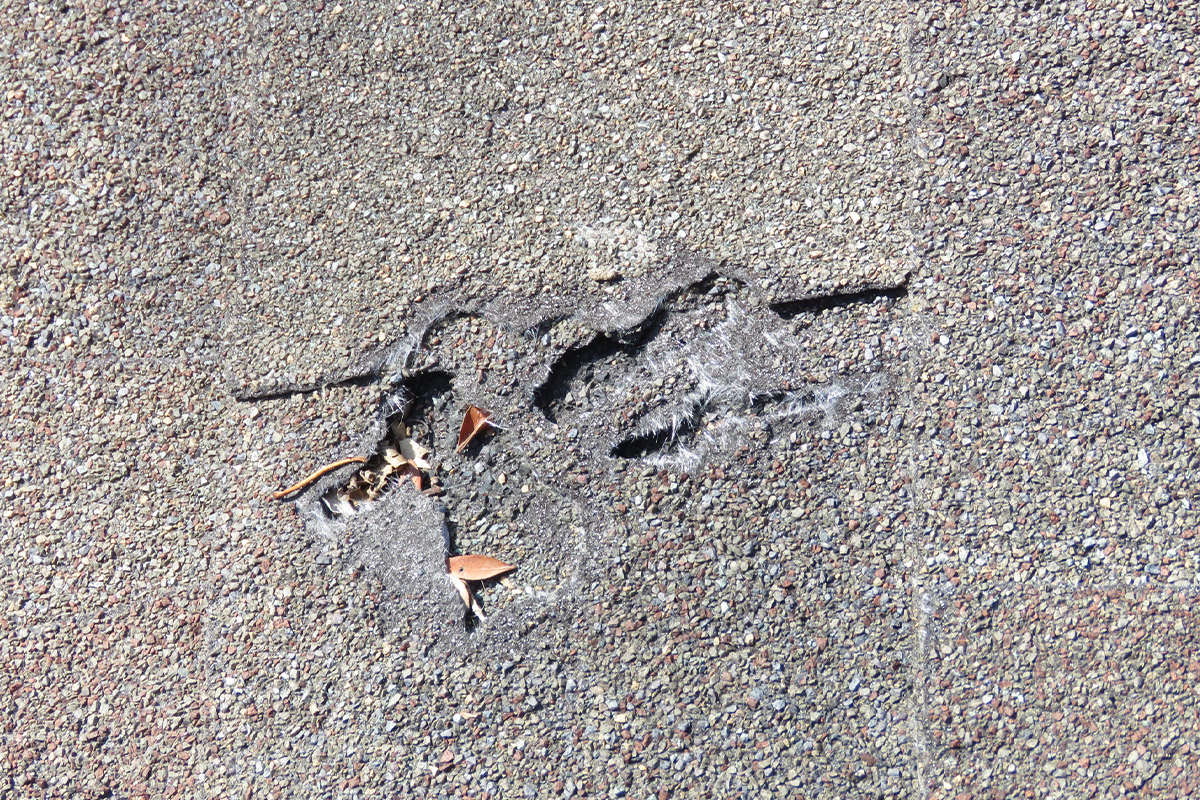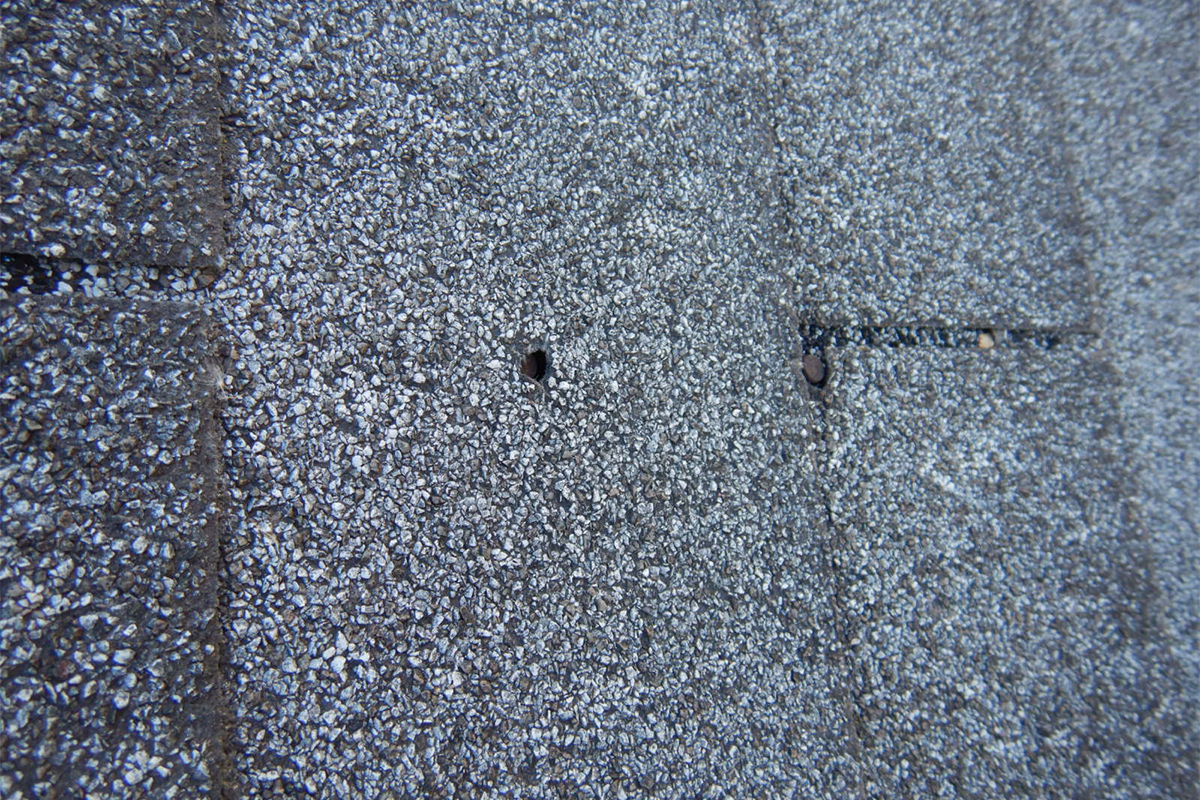Your Guide To Roofing Hail Damage
Hail damage is defined as an identifiable mark or blemish caused by hail that has measurably reduced the functionality of the overall shingle. The shingle must also have been sound prior to the hail impact.
It’s not easy to get a good look at hail impacts to a roof as they’re happening. Use our interactive hail size comparison guide to drop hailstones on different roofing materials and learn more about the kind of damage hail can cause.
Hail Size Comparison Guide
Hover over the roof coverings to see the damage the hail would cause.


The dime-sized hail did not damage this three-tab asphalt shingle. It’s unlikely to damage dimensional-style shingles, or clay or concrete tiles.
Dime-Sized Hail
0.75 inch
43 MPH
Dime-sized (0.75-inch) hail has a terminal velocity of 43 miles per hour (mph). About 82% of hailstones are 0.75 inches in diameter or smaller. Dime-sized hail doesn’t have sufficient mass to damage asphalt shingles, or clay or concrete tiles.



Quarter-Sized Hail
1 inch
50 MPH
Quarter-sized (1-inch) hail has a terminal velocity of 50 mph and can bruise or fracture three-tab asphalt shingles, but it doesn’t have sufficient mass to damage dimensional-style asphalt shingles or clay or concrete tiles. Only 10% of hailstones are quarter-sized.



The half dollar-sized hail fractured this dimensional shingle, exposing the asphalt layer below the granulated layer and reducing the life of the shingle.
Half Dollar-Sized Hail
1.25 Inch
56 MPH
Half dollar-sized (1.25-inch) hail has a terminal velocity of 56 mph and can bruise or fracture dimensional-stye and three-tab asphalt shingles, but it doesn’t have sufficient mass to damage the majority of the tile. Only 4% of hailstones are half dollar-sized hail.



The ping pong ball-sized hail chipped this clay tile. This may allow water to penetrate under the tile, leading to further water-related damages.
Ping Pong Ball-Sized hail
1.5 inch
61 MPH
Ping pong ball-sized (1.5-inch) hail has a terminal velocity of 61 mph and can shatter or break clay tiles, and bruise or fracture asphalt shingles. Outside of the more fragile tile edges, it doesn’t have sufficient mass to damage concrete tiles. Only 2% of hailstones are approximately 1.5 inches in diameter.



Golf Ball-Sized Hail
1.75 inch
66 MPH
Golf ball-sized (1.75-inch) hail has a terminal velocity of 66 mph, and it can shatter clay or concrete tiles, and bruise or fracture asphalt shingles. Roofs damaged by 1.75-inch hail may need to be spot repaired or replaced to return the property to pre-loss condition. Less than 2% of hailstones are 1.75+ inches in diameter.

Roofing Hail Damage
Click through the gallery to see examples of hail damage to roofing materials.
- ‹ prev
- next ›
- 1
- 2
- 3
- 4
- 5
- 6
- 7

Other Causes of Loss
You've seen what kind of impacts hail can have and what damage it can cause. But let's look at other causes of loss that people often confuse with hail. Scroll through the gallery to see photos of claims that were originally attributed to hail but were recategorized by Donan’s experts.

The homeowners filed a claim for hail damage to this roof, but these irregularly shaped areas of granule loss are evidence of human-caused damage.
These crater-shaped blemishes with localized granule loss were caused by heat blisters, not hail. Heat blisters form within the shingles when hot vapors from the asphalt build and then pop, leaving a hole in the granule surface.


Moss and lichen entwine shingle granules with their roots, taking the granules with them when they’re removed. Moss and lichen growth has caused widespread granule loss to the shingles on this roof.
This shingle hasn’t been damaged by hail. Instead, it shows animal damage, likely from birds searching for seeds or insects beneath the shingle.


This blemish was caused by a nail pop, meaning that the nail punctured the shingle after backing out of the decking after installation, which is caused by expansion and contraction in the wooden roof decking.
Bottom right corner tile cracks are rarely evidence of hail impacts. It’s more likely that the tiles were installed too tightly together without leaving enough play for expansion and contraction.


The gray-colored chips on these ridge cap tiles are not consistent with hail damage. A Donan engineer determined that the chips were consistent with windborne debris impact.
Longitudinal cracks in clay or concrete tiles are not caused by hail impacts. The Donan engineer who examined this roof determined that this crack was the result of human-caused damage.


Other Causes of Loss
You've seen what kind of impacts hail can have and what damage it can cause. But let's look at other causes of loss that people often confuse with hail. Scroll through the gallery to see photos of claims that were originally attributed to hail but were recategorized by Donan’s experts.

The homeowners filed a claim for hail damage to this roof, but these irregularly shaped areas of granule loss are evidence of human-caused damage.

These crater-shaped blemishes with localized granule loss were caused by heat blisters, not hail. Heat blisters form within the shingles when hot vapors from the asphalt build and then pop, leaving a hole in the granule surface.

Moss and lichen entwine shingle granules with their roots, taking the granules with them when they’re removed. Moss and lichen growth has caused widespread granule loss to the shingles on this roof.

This shingle hasn’t been damaged by hail. Instead, it shows animal damage, likely from birds searching for seeds or insects beneath the shingle.

This blemish was caused by a nail pop, meaning that the nail punctured the shingle after backing out of the decking after installation, which is caused by expansion and contraction in the wooden roof decking.

Bottom right corner tile cracks are rarely evidence of hail impacts. It’s more likely that the tiles were installed too tightly together without leaving enough play for expansion and contraction.

The gray-colored chips on these ridge cap tiles are not consistent with hail damage. A Donan engineer determined that the chips were consistent with windborne debris impact.

Longitudinal cracks in clay or concrete tiles are not caused by hail impacts. The Donan engineer who examined this roof determined that this crack was the result of human-caused damage.
More Hail Damage Resources

There’s still more to learn about perils that may impact roofing materials. Download our guide, 5 Things That Could Look Like Hail Damage But Aren’t, to learn more about how we define hail damage, how to identify hail impacts, and five causes of roof blemishes that aren’t hail damage but could resemble it to the untrained eye.
Hail events are common in the United States and can cause millions of dollars in insured losses. Read our article, Identifying Hail Damage to Asphalt Shingle Roofs, to find out why hail damage reports are so common and what collateral indicators can confirm hail damage to a roof.




